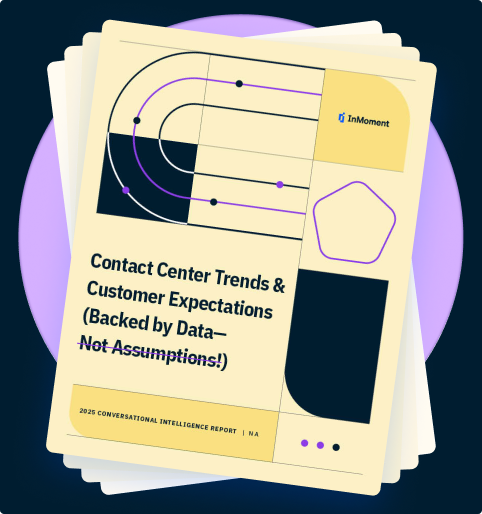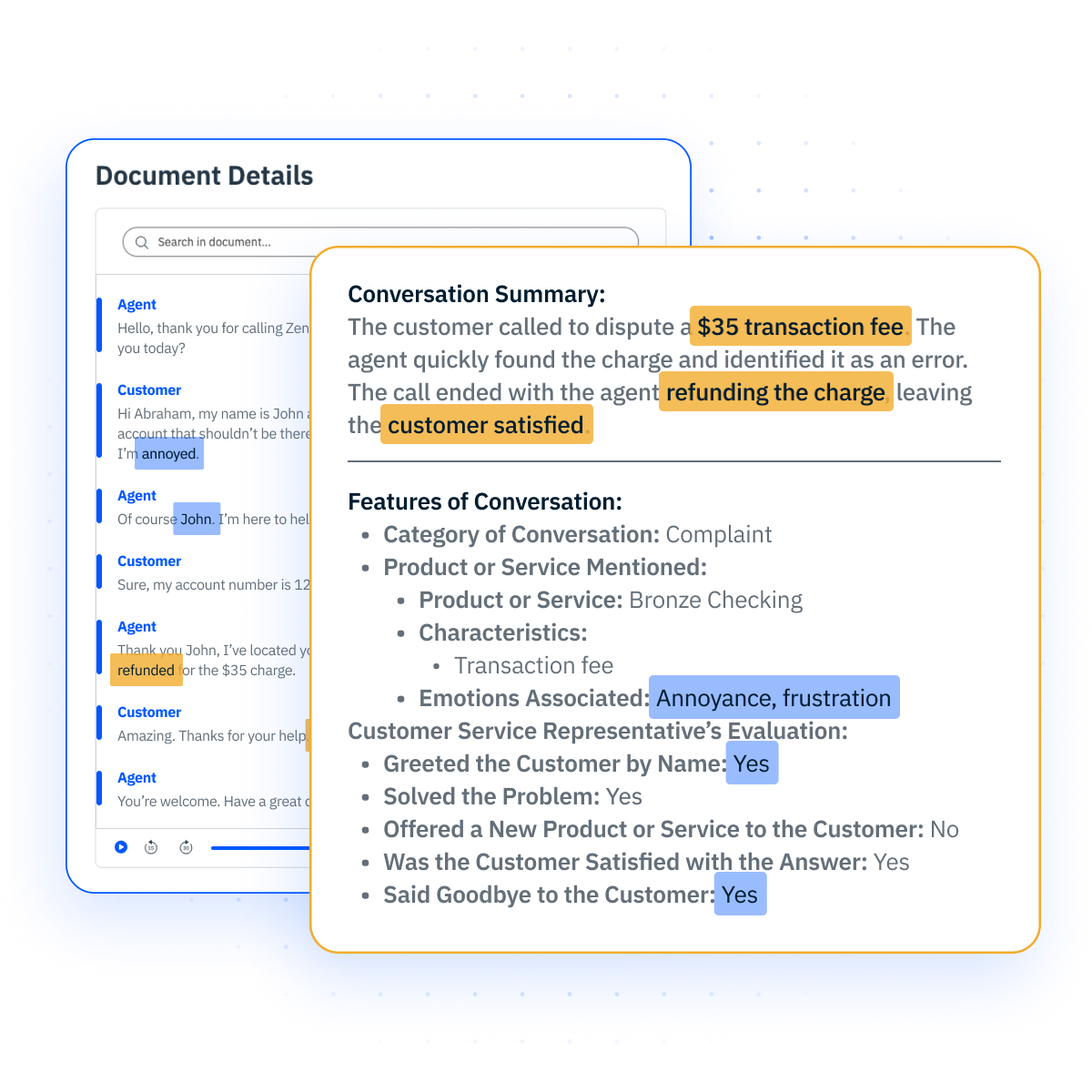How Conversational Intelligence Is Reshaping the Client Experience in Finance
Explore how conversational intelligence is transforming client experiences in financial services through real-time insights, personalization, and efficiency.
Financial institutions are dealing with growing customer expectations while staying compliant with stricter data privacy laws. With over 50 percent of customers willing to switch banks after one negative experience, organizations can’t afford to rest on their laurels.
It’s increasingly important to meet modern expectations with data-driven tools. Conversational intelligence presents a powerful solution for financial service providers in this regard.
How does conversational intelligence enhance customer experience in financial services?
Personalization, speed, and trust are non-negotiables for the modern financial services customer. According to the 2023 Zendesk CX Trends Report, 72% of banking customers demand immediate service, while 62% agree that personalized interactions are better than general ones.
Conversational Intelligence (CI) moves beyond traditional customer support to provide analytical insights into evolving customer behaviors. Here are three key benefits of conversational AI for financial services:
Deeper CX insights
With thousands of conversations happening across customer support channels, financial service providers have a wealth of data containing untapped insight. CI empowers them to build rich datasets from these interactions and analyze them for real-time signals about pain points and expectations.
For example, conversational artificial intelligence uses algorithms trained on transaction histories to predict future engagement levels. This insight can help identify potential cases of churn, highlight the creditworthiness of account holders, and surface products that should be recommended to customers. This predictive analysis supports proactive service, leading to an enhanced customer experience.
Increasing first-call resolution (FCR)
Conversation banking also provides insight into recurring customer queries. From credit card complaints to payment disputes, customers bring forth a range of pain points that agents are expected to resolve. Digging into their conversations highlights common issues, allowing agents to update their knowledge bases for faster resolution.
As a result, agents succeed in improving key call center metrics like first-call resolution (FCR), which tracks the percentage of customer inquiries that agents resolve after the first call. The downstream effect of fewer repeat calls is lower operational costs, enabling financial services to achieve profitability while boosting trust.
Improving agent performance and consistency
Even the most skilled human agents struggle with message consistency, empathy, and real-time recall under pressure. CI supports them by providing real-time guidance during live interactions, helping agents maintain compliance and deliver consistent experiences.
For instance, if an agent forgets to mention a required disclosure during a loan application discussion, CI can prompt them right away. Over time, aggregated insights support personalized training and performance reviews, empowering agents to put their best foot forward in each interaction.
Key use cases of conversational intelligence in finance
Financial institutions leverage conversational AI to improve operational efficiency and deliver better CX outcomes. Here are seven use cases demonstrating the impact of AI in financial services:
Improving call center and support interactions
Modern contact centers in the banking industry face immense pressure to reduce costs while delivering frictionless customer service. A tool like InMoment conversation analytics helps achieve these twin goals through intelligent routing, automating responses to routine tasks, and highlighting areas for improvement across large call volumes. The result is a streamlined experience that boosts customer satisfaction and loyalty.
Training and coaching financial advisors or agents
Conversational data analysis also empowers managers to create effective agent coaching programs. From flagging behavioral patterns and skill gaps to suggesting next-best steps, the analytical insights help improve financial advice quality and agent confidence.
Personalizing client experiences at scale.
Customers expect their banks to understand their unique goals and pain points. When they present a query, they look forward to a response that makes them feel heard and valued.
It’s no wonder, then, that personalization drives positive experiences, with financial services starting to sit up and take notice. Over 85% of financial brands highlighted personalization as their strategic North Star in a 2023 survey by Dynamic Yield.
CI supports personalization efforts by leveraging sentiment analysis on customer data, including feedback and past interactions. The insights into customer emotion and intent help agents tailor their responses, offers, and advice to individual needs.
With InMoment’s patented, AI-driven Active Listening™, you can go one step further by simplifying the response generation process. The tool leverages generative AI to intelligently respond to customers during the feedback process, resulting in richer insights.
Driving proactive client engagement
CI ensures proactive customer engagement through deep analysis of behavioral signals and recurring queries. For example, it can detect frequently asked questions about topics like mortgage eligibility in conversational data. The tool uses the information to signal upsell opportunities and prompt timely follow-ups from agents. Agents can then take immediate action to address the pressing customer need, boosting conversion and retention rates.
Ensuring compliance and risk management
Risk management is a top priority for financial institutions, with rising scrutiny on data privacy and disclosure accuracy. CI helps ensure regulatory compliance by monitoring conversations for flagged language, missing disclosures, and script deviations. This automation prevents the need for manually reviewing thousands of interactions, which is error-prone and unproductive. Instead, compliance teams can confidently detect potential violations, audit conversations, and reduce legal exposure.
Automating how calls are categorized
Accurate call categorization helps teams analyze trends, prioritize resources, and allocate follow-up. Conversational AI tools use machine learning to auto-detect customer intent and apply the correct categories in real time. Just like with compliance, CI eliminates manual work in call categorization, improving reporting accuracy and reducing agent workload.
Identifying and resolving root cause behind issues
Instead of simply chasing metrics, financial institutions must surface insights from the numbers. For instance, a low average handle time looks good on paper until you realize agents are rushing their calls! The best way to stay competitive and take insight-driven action is by addressing the root cause behind customer service issues.
CI supports this important step by aggregating interaction data across your channels to unveil recurring issues. This visibility helps CX teams identify the underlying issue, whether it’s low agent confidence, a training gap, or a systemic flaw. The outcome is better experiences, fewer support calls, and significant cost savings.
How to implement conversational intelligence in financial services
The right approach empowers financial services providers to smoothly integrate CI into their workflows. The following steps are key to unlocking powerful insights, improving customer experiences, and enhancing operational efficiency.
1. Define objectives and map customer journeys
Start by identifying the specific goals your CI tool should support. For instance, improving customer satisfaction is a primary goal for customer-centric organizations, but maybe you’ve been hitting the mark there. Perhaps a bigger problem for you is the rising cost of contact center operations. Or maybe you want to ensure stricter compliance due to recent policy changes.
The next step is to map out key customer journeys where valuable conversations occur. These journeys could include onboarding, loan processing, or any customer interaction with your bank. The idea is to identify high-impact moments where you can focus your CI efforts.
2. Use the right conversational intelligence platform
The right CI platform offers omnichannel coverage, tried-and-tested Natural Language Processing (NLP) models, and seamless integration with your existing systems.
InMoment’s conversational intelligence software goes beyond these features to support your regulatory compliance goals as well. It leverages accurate in-house transcription to safely capture the entirety of each agent-customer interaction for audit purposes. The tool uses machine learning to flag missing disclosures, suspicious recommendations, and other areas where the agent may not be acting in the customer’s best interests.
As a result, you don’t have to invest valuable hours into unproductive manual audits. You free up more time for building stronger customer relationships and improving key aspects of the banking experience.
3. Educate and train team members
Effective CI implementation depends on adoption. Ensure agents, advisors, analysts, and managers understand how to use the new tools and interpret insights correctly.
Offer hands-on training sessions that explain how CI empowers agents in their daily tasks. Highlight the tool’s ability to support real-time decision-making and ensure compliance in each interaction. Educated agents not only perform better with CI but also become internal advocates, which helps streamline CI adoption across other teams.
4. Operationalize insights across teams and touchpoints
The true value of AI in financial CX lies in transforming analytical insights into action. Establish cross-functional workflows to ensure that customer data and feedback loops inform everything from chatbot training to script updates and escalation paths.
For example, if CI highlights growing dissatisfaction with a product release, communicate it to your developers and marketing team. Work with them to implement the necessary fixes and inform customers with timely and effective updates. Don’t let insights sit on the dashboard—embed them into workflows to stay competitive and customer-centric.
Power smarter, more personalized experiences in finance with InMoment
With personalization and smoother banking influencing customer decisions, an AI-powered CX strategy is more important than ever before. It takes care of the analytical workload for thousands of customer interactions, providing valuable insights so you don’t have to guess at what works.
With InMoment’s conversational intelligence tool for financial services, you can track and improve key contact center metrics to move ahead of the pack. Schedule a demo today to see how our analytics and automation help you meet modern customer needs while reducing risk exposure!





